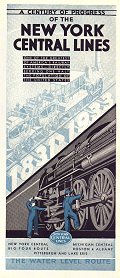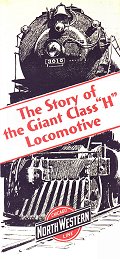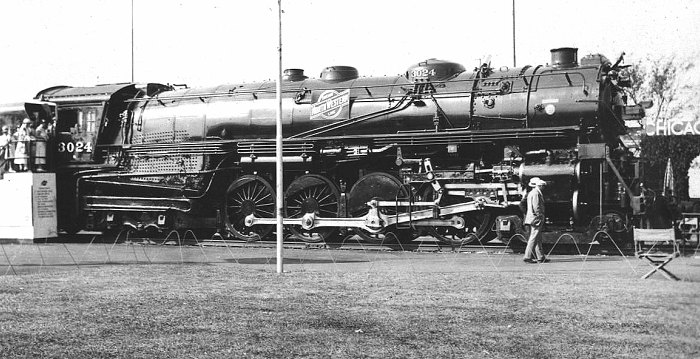 Another visitor to the Century of Progress, a year after the Wickhams' visit, was my father, Richard D. Leonard, then a Methodist pastor in Grand Isle, Vermont. He and a friend made a motor trip to Nebraska in September 1934, during which he visited the Exposition. In a postcard to my grandmother, Julia Day Leonard of Newtonville, Massachusetts, he wrote, "Did the Fair in two days, and it came up to expectations. It is certainly very interesting and instructive." While touring the Century of Progress, he picked up several leaflets describing locomotives that were on exhibit. Thus my father's small collection of railroadiana included this Century of Progress brochure issued by the New York Central Lines, touting the proud Water Level Route's progress in rail technology over the preceding century. The cover image, featuring two enginemen servicing one of the Central's famous Class J-1 4-6-4 passenger steeds, is presented in dramatic art deco styling to camouflage the locomotive's non-streamlined profile. The railroad's notable Commodore Vanderbilt, Empire State Express and Twentieth Century Limited streamlined Hudson type locomotives — and the Mercury, which was a Pacific type — were to come during the next few years.
Another visitor to the Century of Progress, a year after the Wickhams' visit, was my father, Richard D. Leonard, then a Methodist pastor in Grand Isle, Vermont. He and a friend made a motor trip to Nebraska in September 1934, during which he visited the Exposition. In a postcard to my grandmother, Julia Day Leonard of Newtonville, Massachusetts, he wrote, "Did the Fair in two days, and it came up to expectations. It is certainly very interesting and instructive." While touring the Century of Progress, he picked up several leaflets describing locomotives that were on exhibit. Thus my father's small collection of railroadiana included this Century of Progress brochure issued by the New York Central Lines, touting the proud Water Level Route's progress in rail technology over the preceding century. The cover image, featuring two enginemen servicing one of the Central's famous Class J-1 4-6-4 passenger steeds, is presented in dramatic art deco styling to camouflage the locomotive's non-streamlined profile. The railroad's notable Commodore Vanderbilt, Empire State Express and Twentieth Century Limited streamlined Hudson type locomotives — and the Mercury, which was a Pacific type — were to come during the next few years.
 Among the other leaflets in my father's collection were two handouts produced by the Chicago & North Western Railroad describing its newest locomotives, the giant Class H 4-8-4s built by Baldwin Locomotive Works in 1929. These leaflets are reproduced in our C&NW Historical Booklet section. "Zeppelins of the Rails" was the unlikely epithet the railroad attempted to pin on these behemoths. Weighing in at 498,000 pounds minus tender, they were the heaviest non-compound locomotives in service in North America. In one leaflet, pictured at right, the railroad stated, "There are 35 of these mammoth locomotives now in service . . ., each representing a cost of $120,000. They perform a dual service, being used either as passenger or freight locomotives . . . and the transition from one to the other is simply a matter of pulling a lever!" When used in passenger service, the railroad stated, the power of these engines "eliminates jerky stops and starts" and allows the train to maintain an even speed both uphill and down. These engines were also fitted with Automatic Train Control, a safety feature which would stop the train if the track ahead was not clear.
Among the other leaflets in my father's collection were two handouts produced by the Chicago & North Western Railroad describing its newest locomotives, the giant Class H 4-8-4s built by Baldwin Locomotive Works in 1929. These leaflets are reproduced in our C&NW Historical Booklet section. "Zeppelins of the Rails" was the unlikely epithet the railroad attempted to pin on these behemoths. Weighing in at 498,000 pounds minus tender, they were the heaviest non-compound locomotives in service in North America. In one leaflet, pictured at right, the railroad stated, "There are 35 of these mammoth locomotives now in service . . ., each representing a cost of $120,000. They perform a dual service, being used either as passenger or freight locomotives . . . and the transition from one to the other is simply a matter of pulling a lever!" When used in passenger service, the railroad stated, the power of these engines "eliminates jerky stops and starts" and allows the train to maintain an even speed both uphill and down. These engines were also fitted with Automatic Train Control, a safety feature which would stop the train if the track ahead was not clear.
No. 3024 was the Class H's representative in 1933 when the Wickham family toured the Century of Progress. Boasting cylinder dimensions of 27x32 inches, with a working boiler pressure of 275 pounds and 76-inch drivers, these engines produced 71,000 pounds of tractive force augmented by a booster which raised the total to 84,200 pounds. The first five (3001-3005) had Baker valve gears but the rest, including No. 3024, had Walschaerts motion. The locomotive's main frame, including the cylinders, was a single steel casting 58 feet 3 inches long and weighing 73,000 pounds. Like other North American locomotives which were among the first to be erected with a four-wheel trailing truck, the Class H locomotives featured the outside-cradle or "banjo" frame in which the rear portion split to the sides of the locomotive to allow for the deeper firebox and larger truck casting. In the photograph this portion of the frame is visible as the horizontal bar over the rear wheel journals. This type of frame was subject to cracking and required frequent maintenance; in 1946-1949 the C&NW rebuilt 24 of these locomotives into class H-1 with internal frames, disc drivers and other improvements.
My father, Rev. Richard D. Leonard, moved from Vermont to Chicago in 1935 to pursue a Ph.D. at the University of Chicago. While there he occasionally traveled by rail to preaching assignments in outlying communities. A record of his activities is preserved in correspondence to my grandmother. On Sunday, April 5, 1936 — less than six weeks before his marriage to my mother Kay Campbell of Chicago — he wrote to my grandmother: "I got a call from Mr. Alderton [a church official] to go out west of Chicago on the C.& N.W. about 44 miles to a town called Elburn and that is where I am now. . . . It is on the main line of the C.& N.W. (Chicago-Omaha) which runs right by the house, and furthermore, where I slept I could look out and see the trains with hardly a move. There were trains thick and fast all night long — a lot of traffic, almost as close as the signal system would permit and all rushing along at great speed. Once there were three freights right together, then two heavy passenger, then two more freights, all with the same type of locomotive, the famous 3000 class with 76-inch drivers, the largest simple locomotives in the world. Evidently the road operates on this basis of one type of engine and one speed schedule for both freight and passenger."
